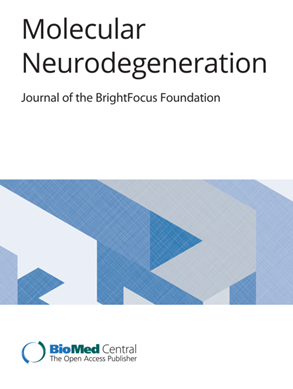增强子突变导致MEF2C功能丧失导致小鼠神经元线粒体功能障碍和运动缺陷
IF 17.5
1区 医学
Q1 NEUROSCIENCES
引用次数: 0
摘要
肌萎缩性侧索硬化症(ALS)是一种致命的神经退行性疾病,其特征是上下运动神经元的丧失,导致进行性瘫痪。在ALS的发病机制中,遗传改变和表观遗传改变都与神经元功能障碍有关。然而,影响表观遗传修饰的基因非编码区基因突变背后的机制尚不清楚。使用卷积神经网络鉴定了位于MEF2C内含子区域(rs304152)的als相关SNP,该SNP位于假定的增强子元件中。为了检测SNP对MEF2C转录的改变,我们通过CRISPR-Cas9生成了携带主要或次要等位基因的HEK293T细胞。为了验证MEF2C敲低(MEF2C- kd)在小鼠中的作用,我们基于AAV- u6启动子载体构建了表达MEF2C的AAV shRNA。用共聚焦显微镜和透射电镜观察线粒体功能障碍和运动神经元损伤的MEF2C-KD小鼠的神经病理改变。采用悬尾纵向研究、倒网格实验和自动步态分析等方法观察小鼠的行为学变化。在这里,我们发现MEF2C增强子突变降低了自身基因的表达,从而损害了运动神经元的线粒体功能。MEF2C定位并结合线粒体DNA,直接调节线粒体编码基因的表达。CRISPR/ cas -9诱导的MEF2C增强子突变降低了线粒体编码基因的表达。此外,MEF2C突变细胞显示线粒体膜电位和ATP水平降低,但氧化应激升高。小鼠上下运动神经元MEF2C缺乏会损害线粒体编码基因,导致线粒体代谢紊乱和进行性运动行为缺陷。增强子突变导致的MEF2C失调共同导致线粒体功能障碍和氧化应激,这是运动神经元损伤和ALS发病机制的普遍特征。这种遗传和表观遗传的串扰机制为促进我们对运动神经元疾病的理解和开发有效的治疗方法提供了见解。本文章由计算机程序翻译,如有差异,请以英文原文为准。
Loss of MEF2C function by enhancer mutation leads to neuronal mitochondria dysfunction and motor deficits in mice
Amyotrophic lateral sclerosis (ALS) is a fatal neurodegenerative disorder characterized by the loss of both upper and lower motor neurons, leading to progressive paralysis. Both genetic alterations and epigenetic modifications contribute to neuronal dysfunction in the pathogenesis of ALS. However, the mechanism behind genetic mutations in the non-coding region of genes that affect epigenetic modifications remains unclear. Convolutional neural network was used to identify an ALS-associated SNP located in the intronic region of MEF2C (rs304152), residing in a putative enhancer element. To examine the alteration of MEF2C transcription by the SNP, we generated HEK293T cells carrying the major or minor allele by CRISPR-Cas9. To verify the role of MEF2C-knockdown (MEF2C-KD) in mice, we developed AAV expressing shRNA for MEF2C based on AAV-U6 promoter vector. Neuropathological alterations of MEF2C-KD mice with mitochondrial dysfunction and motor neuronal damage were observed by confocal microscopy and transmission electron microscope (TEM). Behavioral changes of mice were examined through longitudinal study by tail suspension, inverted grid test and automated gait analysis. Here, we show that enhancer mutation of MEF2C reduces own gene expression and consequently impairs mitochondrial function in motor neurons. MEF2C localizes and binds to the mitochondria DNA, and directly modulates mitochondria-encoded gene expression. CRISPR/Cas-9-induced mutation of the MEF2C enhancer decreases expression of mitochondria-encoded genes. Moreover, MEF2C mutant cells show reduction of mitochondrial membrane potential, ATP level but elevation of oxidative stress. MEF2C deficiency in the upper and lower motor neurons of mice impairs mitochondria-encoded genes, and leads to mitochondrial metabolic disruption and progressive motor behavioral deficits. Together, MEF2C dysregulation by the enhancer mutation leads to mitochondrial dysfunction and oxidative stress, which are prevalent features in motor neuronal damage and ALS pathogenesis. This genetic and epigenetic crosstalk mechanism provides insights for advancing our understanding of motor neuron disease and developing effective treatments.
求助全文
通过发布文献求助,成功后即可免费获取论文全文。
去求助
来源期刊

Molecular Neurodegeneration
医学-神经科学
CiteScore
23.00
自引率
4.60%
发文量
78
审稿时长
6-12 weeks
期刊介绍:
Molecular Neurodegeneration, an open-access, peer-reviewed journal, comprehensively covers neurodegeneration research at the molecular and cellular levels.
Neurodegenerative diseases, such as Alzheimer's, Parkinson's, Huntington's, and prion diseases, fall under its purview. These disorders, often linked to advanced aging and characterized by varying degrees of dementia, pose a significant public health concern with the growing aging population. Recent strides in understanding the molecular and cellular mechanisms of these neurodegenerative disorders offer valuable insights into their pathogenesis.
 求助内容:
求助内容: 应助结果提醒方式:
应助结果提醒方式:


